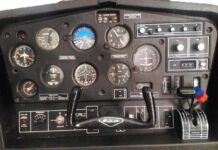Steam (Gauge) Power
Your last editorial really resonated with me (“Black Ops for Black Boxes,” April 2012 IFR). I have been flying on and off for over 50 years, and almost always behind round gauges; sometimes not very many of them.
When I bought my new Commander 114TC in 1999, I opted for what was then pretty much state of the art. Lots of conventional, round gauges plus two swanky, new, GNS 430s. Thirteen years on, the configuration is pretty much unchanged, except for an electric backup AI and the addition of WX weather to the Garmins. I do worry a bit about gyro failure, but I have dual vacuum pumps and know that I can hand fly well enough using the backup and the Garmins. I’ve thought about adding WAAS and also traffic info, but as I almost always fly IFR and into fields with at least one ILS, I’ve yet to bite those bullets.
I’ve trained on the G1000, but even if I could install it for free, I think I’d stick to my existing configuration. I know where everything is and how it behaves. The knobs are mainly on the Garmins and the autopilot and I’ve had plenty of time to master those. I certainly don’t need more knobs in my life.
When the time comes, I suppose my resale value may be adversely affected by this old-fart cockpit, but as it’s most likely to be my estate doing the selling, I can’t even get too worried about that!
Long live analog gauges!
John Ward
Brewster, Mass.
In response to “Black Ops for Black Boxes”: Right on! We have more functionality than we can use. I know there are still guys out there with blinking VCRs (OK, who really still has a VCR?), but let’s make the black boxes more customizable and allow users to choose which functionality they want to hide in the back or keep it in the forefront.
When you fly daily, you tend to use the same tools, over and over. Why not program it just to just those things and keep in the other stuff on the backburner when you need it?
Mike Johnson
Cleveland, Ohio
Say (Your) Intentions
“Smooth Talker” (April 2012 IFR) is one of probably dozens of articles I’ve read on communications with ATC. This one touched on conserving frequency
“space” and reminds me of one of the biggest communication pet peeves I had before I retired as a controller, but have never seen in print:
The destination airport is uncontrolled, weather is good VFR, and ATC requests the pilot to “report the airport in sight for a visual approach.” The following conversation ensues:
Pilot acquires the airport visually and states, “(Aircraft ID) has (XYZ) airport in sight.”
Controller: “(Aircraft ID), cleared visual approach to (XYZ) airport, report cancellation this frequency, or on the ground with (ABC) Radio. Change to advisory frequency approved.”
Pilot: “We’ll just cancel the IFR.”
Controller: “(Aircraft ID), squawk VFR, frequency change approved.”
If the pilot is planning to cancel soon anyway, why doesn’t the pilot just do so in the first place (instead of reporting the airport in sight) and save all the other extraneous conversation?
Ninety-five percent of the time, the scenario occurs as above. Radar service is automatically terminated when ATC approves a frequency change, so no more service is to be expected. A good controller will issue any potential traffic before releasing the aircraft, but is required to do so in a timely manner.
This is not to suggest if you have any reason to maintain your IFR clearance you shouldn’t do so, but I think most pilots will admit that the vast majority of time, very little is to be gained by not canceling in good weather, prior to the issuance of a somewhat verbose visual approach clearance. The frequency time you save may make someone else’s day a little easier, especially in busy Approach airspace.
Kent D. Nicholson
Batavia, Ill.
Seven-Mile Final? Really?
Just finished exploring the April 2012 IFR (a wonderful mag) and noticed something that always concerns me. I think it’s a hangover from the IFR world that is risky on VFR days.
The article “Smooth Talker” says, “… please include VFR terms, such as ‘VAPOR inbound on seven-mile final for Runway 23.’ ” A pilot practicing an IFR approach to an uncontrolled field in VFR conditions calling 12-mile or 7-mile or 5-mile final is claiming right-of-way over anyone who might already be established in the pattern!
One sunny Saturday, a group of us were auto-tow ground-launching a glider in-between VFR takeoffs and landings. Everybody was watching out for each other and taking turns. Then the FBO owner, arriving from a far-off place in his Cessna 310, came on the air: “Seven Two Six Three Bozo, 12-mile final, Runway 27.” He did not respond to any calls from the folks on the field or in the pattern. Ten minutes later, he taxied off the runway and the other pilots resumed their activity. I see this sort of rudeness almost every time I fly.
I fly straight-in approaches myself. But I do think the courteous thing, on VFR days, is to announce, “… eight miles, straight-in approach, Runway 27.” Do this after listening carefully for other traffic and while being prepared to deviate and fly a normal pattern if there’s anyone else at the field.
The AIM and FARs do not at any point define what qualifies for “on final.” I judge that common sense would dictate that it’s fully configured for landing, at or below pattern altitude, and less than two minutes out. It’s never safe or appropriate, when there’s other VFR traffic at an uncontrolled field, to barge in on final without joining others in the pattern.
Danl Johnson
via email
Your point of saying “straight-in” versus “on final” is valid. However, we think in practice many pilots use “on final” simply as a statement of orientation, not as usurping priority. We think the better way to clarify your willingness to let pattern traffic have priority is to say “… eight-mile straight-in, traffic permitting.” Even if you say “final” here, saying you’ll only do it traffic permitting recognizes priority for those dutifully trundling the track.
Staying Sharp, A Bit At A Time
Mr. Robinson’s idea is both simple and extraordinary (“Proficiency in Pieces,” April 2012 IFR). Piecemeal training as he suggests is a great way to maintain on-going currency. As I’m finding out, finding an outlet to get that training is easier said than done. I’m striking out in the Sacramento area, and we’re not that backward, having recently graduated to indoor plumbing and electricity.
What do you think of allowing every FBO that endorses Mr. Robinson’s prescription listed on one of your web pages? Or some variation of that theme?
Steve Gorman
Lincoln, Calif.
We don’t have a particularly active webpage, but if flight schools and freelance CFIs who have programs like this want to contact us, we’ll publish a list in a future issue.
VOR? Wazzat?
A peculiarity of the new Eclipse IFMS is that there is no way to display distance to a second, arbitrary waypoint. You get distance to the next fix and you get VOR/DME displays. So when executing a DME arc, you can cross-check the FMS by tuning the VOR/DME with the bearing navigation source and see the distance. Except, if the VOR is down, you can’t!
Flying the arc at Victorville, Calif., my instructor told me that if we were IFR we would technically not be legal because the FAA requires monitoring of the distance. The only indication we had of our distance was our own ship display on the chart, and the FMS’s assurance in the flight plan that we were on the arc.
Ron Lebel
Sherman Oaks, Calif.
This isn’t true on two counts. Your updated Eclipse has a WAAS GPS, so you’re not even required to have a functioning DME receiver installed, let alone monitor it. See AIM 1-1-20 (c) 7. Guidance on using a GPS in lieu of ADF or DME also says nothing about monitoring the underlying navaid. But even non-WAAS GPS systems don’t need the backup functioning so long as RAIM or FDE is available.
Reach us at [email protected].




